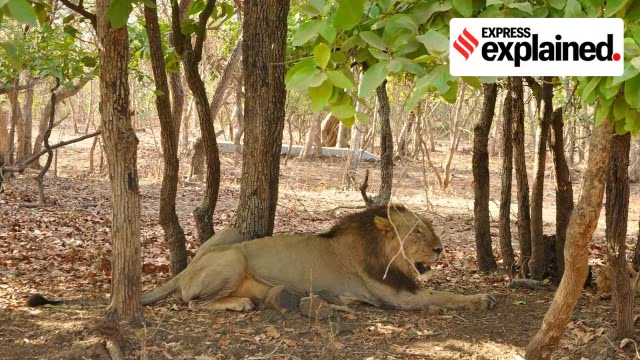
On September 18, the Union Ministry of Environment, Forest and Climate Change (MoEFCC) published a draft notification, proposing to notify 3,328 square kilometres around the Gir forest in Gujarat as an Eco-Sensitive Zone (ESZ). However, a revised draft a week later reduced the scope of the protected area to 2,061 sq km. Forest officers said the reduction was needed to accommodate the basic needs of people living around the forest. Many commercial and infrastructure-building activities are prohibited inside ESZs.
Leaders of both the ruling BJP and opposition parties like the AAP have protested against the proposed ESZ. What led to the protests and why are ESZs declared? We explain.
Why has the Gir ESZ faced criticism?
Successive proposals for notifying an ESZ around the Gir Protected Area (PA) have faced protests from politicians and the public. Gir is a National Park, meaning it enjoys a very high degree of government protection for safeguarding wildlife, and is the last remaining abode of the Asiatic lions.
ESZs essentially act as buffer zones around Protected Areas — national parks, wildlife sanctuaries, tiger reserves, etc. — so that the wildlife has a transition zone around them. The Centre issued the first draft notification for an ESZ around Gir on October 25, 2016, covering 3,328 sq km. Nalin Kotadiya, the MLA of Dhari from the Gujarat Parivartan Party (GPP) (later merged with the BJP) led public protests against the proposal. He said farmers had the right to protect themselves from wild animals while working in their fields.
The state government then sent a revised proposal to the Centre. However, one Biren Padhya moved the Gujarat High Court with a public interest litigation, complaining that the revision reduced the ESZ to 1,114 sq km. The High Court then directed the Central government not to publish the final notification and the order stands to date.
Days after the September 18 notification, whose proposed ESZ covered 196 villages, BJP’s Gir Somnath District Unit President Mahendra Pithiya wrote to Chief Minister Bhupendra Patel. He requested the CM to exempt the villages of Gir Somnath and Junagadh districts from the ESZ as it would “hamper non-agricultural (permissions), and businesses of resorts, small industries etc.”
Dilip Sanghani, Indian Farmers Fertiliser Cooperative (IFFCO) chairman and BJP leader from Amreli, threatened to launch a public agitation if wildlife conservation was done “at the cost of development of villages”. The RSS affiliate Bharatiya Kisan Sangh also raised its voice against the notification.
What makes Gir unique?
Gir PA includes the Gir National Park, the Gir Wildlife Sanctuary, the Paniya Wildlife Sanctuary and the Mitiyala Wildlife Sanctuary, spread across the Junagadh, Amreli and Gir Somnath districts in Gujarat’s Saurashtra region in its south.
It is Gujarat’s largest compact tract of protected forest but is also surrounded by high-density human settlements. Being territorial animals, Asiatic lions started moving out of the forest boundaries in the early 1990s.
Generally, people living on Gir’s periphery have received the big cats well, tolerating the occasional loss of livestock and attacks on humans. Thanks to the government’s conservation efforts and cooperation from the locals, the Asiatic lion population increased from 327 in 2001 to 674 in 2020.
What is the need for eco-sensitive zones?
The National Environment Policy of 2006 defined Eco-Sensitive Zones “as areas/zones with identified environmental resources having incomparable values which require special attention for their conservation”, because of its landscape, wildlife, biodiversity, historical and natural values.
Protected Areas help conserve ecosystems adversely affected by anthropogenic and climatic factors. ESZs then act as shock absorbers for wildlife in PAs when they move from areas of higher environmental protection to lower.
No commercial mining, stone quarrying, large hydroelectric projects, polluting industries, brick kilns, etc. are allowed in ESZ. Commercial establishment of hotels, resorts, small-scale non-polluting industries and the construction of civic amenities are regulated.
As per the MoEFCC, the idea of ESZ was conceived in 2002. Lands falling within 10 km of the boundaries of national parks and sanctuaries were to be notified as ESZs. The National Wildlife Action Plan (NWAP) for the 2002-2016 period indicated that areas outside the protected area network are often “vital ecological corridor links and must be protected to prevent isolation of fragments of biodiversity which will not survive in the long run.”
In 2011, the MoEFCC issued guidelines to declare ESZs, with an indicative list of prohibited, regulated or promoted activities.
Who declares an Eco-Sensitive Zone?
Forest departments of respective state governments are supposed to prepare site-specific ESZ proposals for each PA within their respective states and then forward them to the MoEFCC. After due scrutiny of such proposals, the MoEFCC issues a draft notification, inviting suggestions and objections from people likely to be affected. Such objections and suggestions are to be submitted within 60 days after the publication of the draft notification in a Central government gazette.
The MoEFCC seeks the concerned state’s response to such suggestions and objections. Then, based on the recommendation of an expert committee of ESZ of the MoEFCC, the ministry issues a final ESZ notification.
First Published By The Indian Express on 6 October 2024.